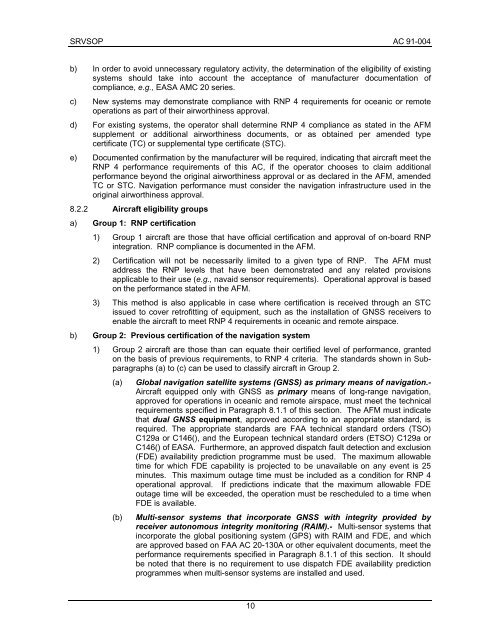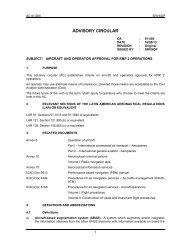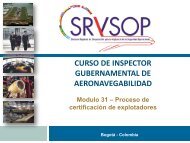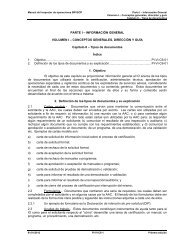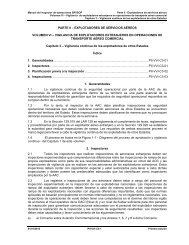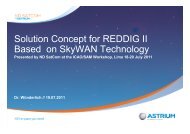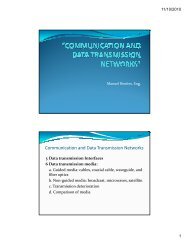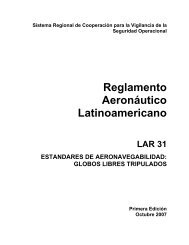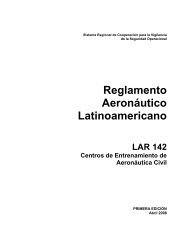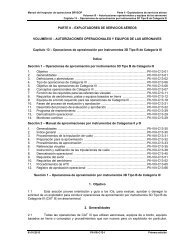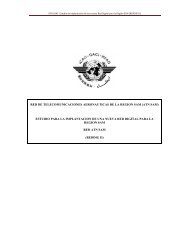ac 91-004 srvsop - ICAO
ac 91-004 srvsop - ICAO
ac 91-004 srvsop - ICAO
Create successful ePaper yourself
Turn your PDF publications into a flip-book with our unique Google optimized e-Paper software.
SRVSOP AC <strong>91</strong>-<strong>004</strong><br />
b) In order to avoid unnecessary regulatory <strong>ac</strong>tivity, the determination of the eligibility of existing<br />
systems should take into <strong>ac</strong>count the <strong>ac</strong>ceptance of manuf<strong>ac</strong>turer documentation of<br />
compliance, e.g., EASA AMC 20 series.<br />
c) New systems may demonstrate compliance with RNP 4 requirements for oceanic or remote<br />
operations as part of their airworthiness approval.<br />
d) For existing systems, the operator shall determine RNP 4 compliance as stated in the AFM<br />
supplement or additional airworthiness documents, or as obtained per amended type<br />
certificate (TC) or supplemental type certificate (STC).<br />
e) Documented confirmation by the manuf<strong>ac</strong>turer will be required, indicating that aircraft meet the<br />
RNP 4 performance requirements of this AC, if the operator chooses to claim additional<br />
performance beyond the original airworthiness approval or as declared in the AFM, amended<br />
TC or STC. Navigation performance must consider the navigation infrastructure used in the<br />
original airworthiness approval.<br />
8.2.2 Aircraft eligibility groups<br />
a) Group 1: RNP certification<br />
1) Group 1 aircraft are those that have official certification and approval of on-board RNP<br />
integration. RNP compliance is documented in the AFM.<br />
2) Certification will not be necessarily limited to a given type of RNP. The AFM must<br />
address the RNP levels that have been demonstrated and any related provisions<br />
applicable to their use (e.g., navaid sensor requirements). Operational approval is based<br />
on the performance stated in the AFM.<br />
3) This method is also applicable in case where certification is received through an STC<br />
issued to cover retrofitting of equipment, such as the installation of GNSS receivers to<br />
enable the aircraft to meet RNP 4 requirements in oceanic and remote airsp<strong>ac</strong>e.<br />
b) Group 2: Previous certification of the navigation system<br />
1) Group 2 aircraft are those than can equate their certified level of performance, granted<br />
on the basis of previous requirements, to RNP 4 criteria. The standards shown in Subparagraphs<br />
(a) to (c) can be used to classify aircraft in Group 2.<br />
(a)<br />
(b)<br />
Global navigation satellite systems (GNSS) as primary means of navigation.-<br />
Aircraft equipped only with GNSS as primary means of long-range navigation,<br />
approved for operations in oceanic and remote airsp<strong>ac</strong>e, must meet the technical<br />
requirements specified in Paragraph 8.1.1 of this section. The AFM must indicate<br />
that dual GNSS equipment, approved <strong>ac</strong>cording to an appropriate standard, is<br />
required. The appropriate standards are FAA technical standard orders (TSO)<br />
C129a or C146(), and the European technical standard orders (ETSO) C129a or<br />
C146() of EASA. Furthermore, an approved dispatch fault detection and exclusion<br />
(FDE) availability prediction programme must be used. The maximum allowable<br />
time for which FDE capability is projected to be unavailable on any event is 25<br />
minutes. This maximum outage time must be included as a condition for RNP 4<br />
operational approval. If predictions indicate that the maximum allowable FDE<br />
outage time will be exceeded, the operation must be rescheduled to a time when<br />
FDE is available.<br />
Multi-sensor systems that incorporate GNSS with integrity provided by<br />
receiver autonomous integrity monitoring (RAIM).- Multi-sensor systems that<br />
incorporate the global positioning system (GPS) with RAIM and FDE, and which<br />
are approved based on FAA AC 20-130A or other equivalent documents, meet the<br />
performance requirements specified in Paragraph 8.1.1 of this section. It should<br />
be noted that there is no requirement to use dispatch FDE availability prediction<br />
programmes when multi-sensor systems are installed and used.<br />
10


